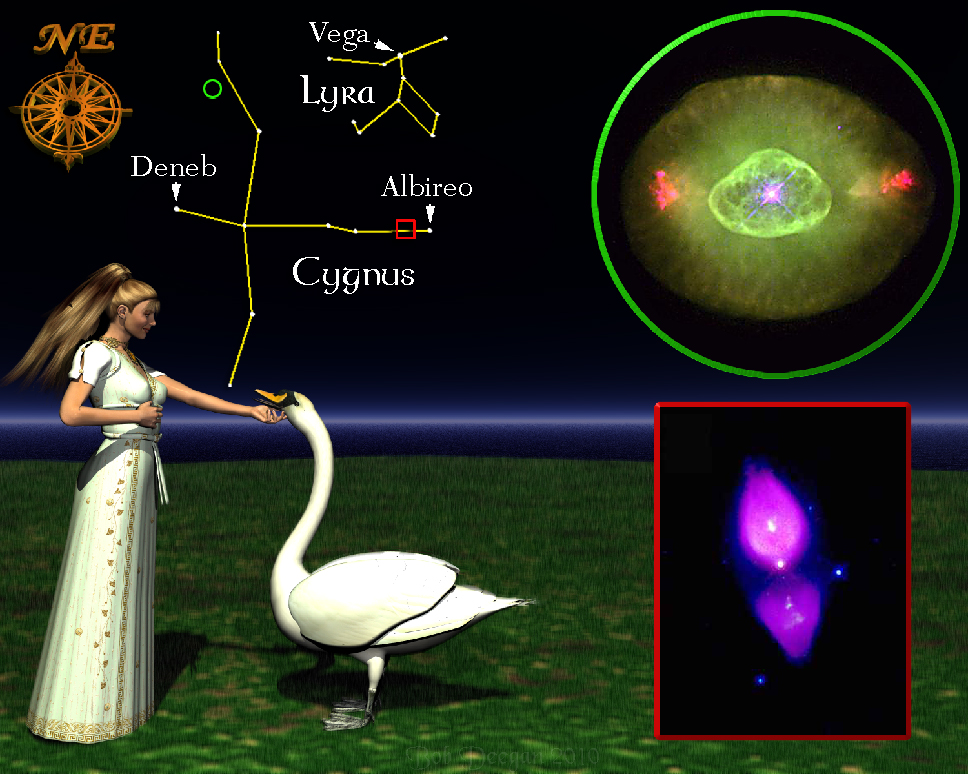
For the week including May 21, 2010

THE SWAN
There’s just something about the stars of Cygnus, the Swan, that draws attention. Even people who know very little about astronomy are able to recognize that these prominent stars ought to be part of a constellation, even if they can’t put their finger on just which constellation it is. But once someone traces the stars that outline the Swan, they have little trouble identifying it in the future. This group of stars, marking the outline of a celestial bird, has been known since the far removed ages of Babylon and Sumeria. During various periods of their histories, these cultures modeled the starry bird after storks, cranes, and even hens. Arabic peoples of a later time said that this was the giant and terrible Roc that battled with Sinbad, the Sailor. The best known story associated with these stars comes from the mythology of ancient Greece. The tale of Leda and the Swan has been immortalized in the works of da Vinci, Michelangelo, Tintoretto, Rubens, and Matisse to name just a few. It seems that the king of the gods, Zeus, became enamored with Leda, the queen of Sparta, and so he disguised himself as a swan and went to visit her. At first, Leda was charmed by the sweet bird, but Zeus had other ideas. According to the poem by William Butler Yeats:
“...A sudden blow: the great wings beating still
Above the staggering girl, her thighs caressed
By the dark webs, her nape caught in his bill…”
Well, you can pretty well guess what Zeus had in mind.
Within the year, Leda gave birth to two sets of twins. One set of twins is among the stars as the constellation of Gemini. Another of the children, Helen, went on to memorable adventures in Troy.
The constellation of Cygnus, the Swan, can be found in the northeast, around midevening. Start by looking at the large blue-white star Vega, in the constellation of Lyra, the Lyre. Vega is the brightest star in the eastern sky and shouldn’t be hard to locate. Once you’ve found it, look downward and to the left and you will come to another bright star. This is Deneb, which marks the tail of the Swan. The Swan’s wings unfold to the right of Deneb and spread across a broad area of sky. Continue scanning to the right and you can follow a trail of faint stars along the Swan’s neck, ending at Albireo, the head of Cygnus.
If you have a telescope, there are wonderful deep-sky objects for you in this constellation and Cygnus will prove well worth an evening out under the stars.
Albireo: The star that marks the Swan’s head is actually a pair of stars. A small telescope will show them both and reveals them to be a hot sapphire blue star with a topaz colored companion. Albireo is by far the most popular binary system viewed by amateur astronomers
NGC 6826 (circled area): The Hubble Space telescope photograph at upper right shows a star like our Sun in its death throes. As the nuclear fuel near its core runs out, the star sheds layer after layer of its outer surface into space. This phase of activity will continue for many thousands of years. The gaseous envelopes of NGC 6826 will eventually dissipate and leave behind a hot white-dwarf star that will slowly cool and fade from view.
Minkowski’s Footprint (squared area): At lower right is a planetary nebula that is also in the early stages of development. Discovered in 1939 by Rudolph Minkowski of the Mount Wilson Observatory, its pronounced lobes give clues about the configuration and composition of its parent star.
Unless otherwise indicated, all content of this web site is the copyright of Robert Deegan and all rights are reserved.
For more information, or to comment, please contact: Bob@NightSkies.org